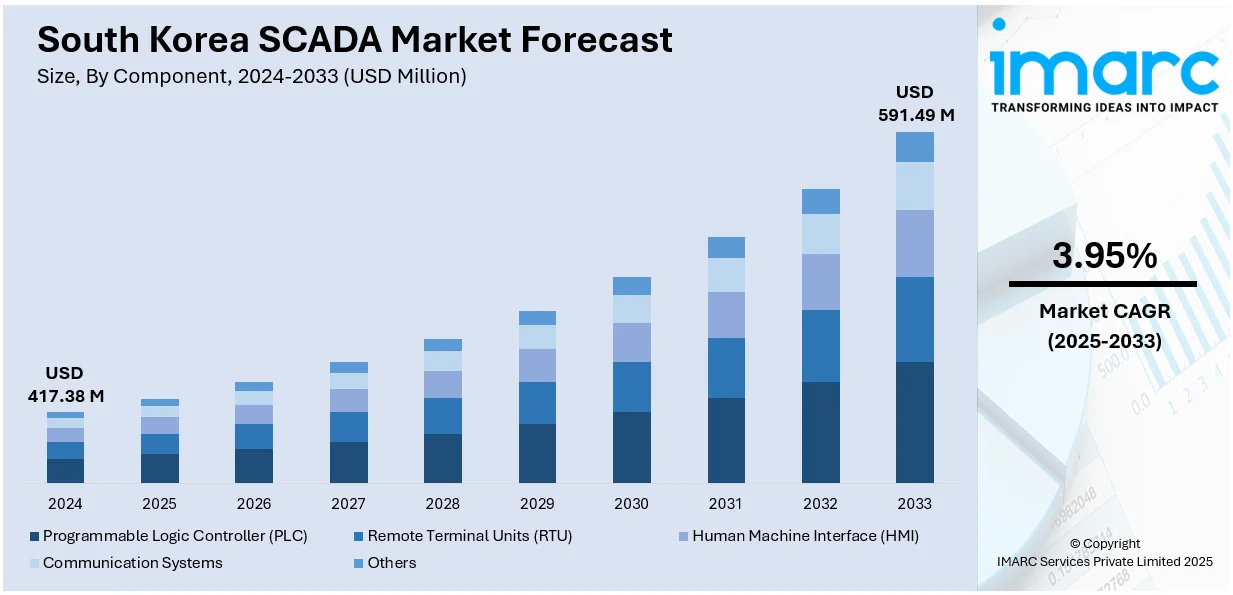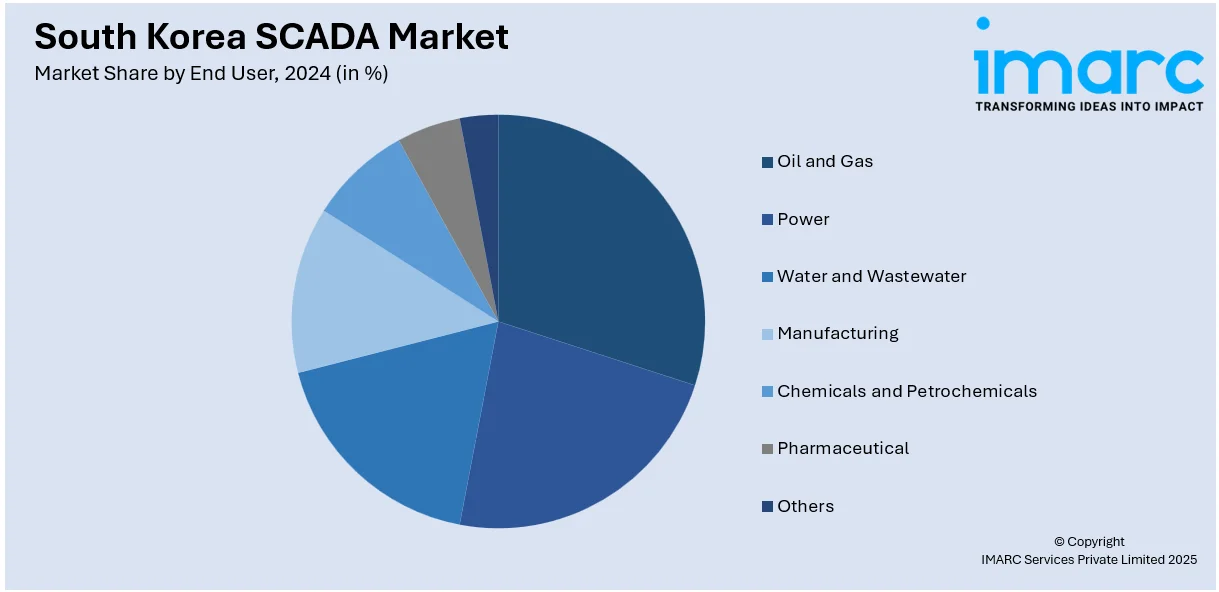
South Korea SCADA Market Size, Share, Trends and Forecast by Component, Architecture, End User, and Region, 2025-2033
South Korea SCADA Market Overview:
The South Korea SCADA market size reached USD 417.38 Million in 2024. Looking forward, the market is expected to reach USD 591.49 Million by 2033, exhibiting a growth rate (CAGR) of 3.95% during 2025-2033. The market is expanding steadily, driven by the rising adoption of industrial automation, increasing demand for real-time monitoring, and growing investments in smart infrastructure. Enhanced cybersecurity measures and integration with IoT technologies are further accelerating implementation across sectors. These advancements are contributing to the continued growth of the South Korea SCADA market share.
|
Report Attribute
|
Key Statistics
|
|---|---|
|
Base Year
|
2024 |
|
Forecast Years
|
2025-2033
|
|
Historical Years
|
2019-2024
|
| Market Size in 2024 | USD 417.38 Million |
| Market Forecast in 2033 | USD 591.49 Million |
| Market Growth Rate 2025-2033 | 3.95% |
South Korea SCADA Market Trends:
Rising Demand for Infrastructure Modernization and Smart Utilities
With South Korea investing heavily in upgrading its infrastructure, such as smart grids, intelligent transportation systems, and advanced water and waste management, SCADA systems are becoming essential for effective supervision and control. Modernization of legacy systems also needs integrated, secure and scalable solutions that can handle distributed assets with a large amount of data. The presence of SCADA in the energy sector allows real-time monitoring of the grid, load balancing, and error identification, especially in balancing increasing volumes of renewable energy inputs. Likewise, SCADA increases efficiency and reliability in the provision of services such as sewage treatment, water distribution, and traffic management in urban utility networks. This newfound interest in the smart infrastructure is largely fueling the rising uptake of SCADA technologies in the country.

To get more information on this market, Request Sample
Growing Industrial Automation Across Key Sectors
South Korea’s strong emphasis on industrial automation, particularly in manufacturing, energy, water treatment, and transportation, is a major factor driving the South Korea SCADA market growth. As industries pursue operational streamlining and automation, less manual interference, and less operating downtime, SCADA platforms represent an efficient and reliable technology solution to real-time monitoring, data retrieval, and control center environments. Industries like electronics, automotive, and petrochemicals are facing the burden of using SCADA to make operations smooth and ensure uniform quality of output. Moreover, the attention of the government to smart factories and the use of Industry 4.0 propositions is encouraging companies to incorporate SCADA into their central systems. This helps in predictive maintenance, maximization of resource utilization, and minimizing operating expense, which again boosts the need for advanced SCADA in the industrial environment present in South Korea.
Integration with IoT, AI, and Cybersecurity Enhancements
The integration of SCADA systems with emerging technologies such as IoT, artificial intelligence, and advanced cybersecurity protocols is transforming their functionality and value. IoT sensors and AI algorithms enable more intelligent data analysis, predictive maintenance, and autonomous decision-making within SCADA frameworks. South Korea’s tech-forward approach encourages the use of interconnected systems that provide deep insights and higher automation across industries. Moreover, with rising cyber threats targeting industrial control systems, robust cybersecurity measures are being embedded into modern SCADA platforms to protect critical infrastructure. This focus on secure, data-driven, and responsive systems is attracting organizations looking for long-term digital control solutions, thereby fueling demand for next-generation SCADA systems across the country.
South Korea SCADA Market Segmentation:
IMARC Group provides an analysis of the key trends in each segment of the market, along with forecasts at the country and regional levels for 2025-2033. Our report has categorized the market based on component, architecture, and end user.
Component Insights:
- Programmable Logic Controller (PLC)
- Remote Terminal Units (RTU)
- Human Machine Interface (HMI)
- Communication Systems
- Others
The report has provided a detailed breakup and analysis of the market based on component. This includes programmable logic controller (PLC), remote terminal units (RTU), human machine interface (HMI), communication systems, and others.
Architecture Insights:
- Hardware
- Software
- Services
A detailed breakup and analysis of the market based on architecture have also been provided in the report. This includes hardware, software, and services.
End User Insights:

- Oil and Gas
- Power
- Water and Wastewater
- Manufacturing
- Chemicals and Petrochemicals
- Pharmaceutical
- Others
A detailed breakup and analysis of the market based on the end user have also been provided in the report. This includes oil and gas, power, water and wastewater, manufacturing, chemicals and petrochemicals, pharmaceutical, and others.
Regional Insights:
- Seoul Capital Area
- Yeongnam (Southeastern Region)
- Honam (Southwestern Region)
- Hoseo (Central Region)
- Others
The report has also provided a comprehensive analysis of all the major regional markets, which include Seoul Capital Area, Yeongnam (Southeastern Region), Honam (Southwestern Region), Hoseo (Central Region), and others.
Competitive Landscape:
The market research report has also provided a comprehensive analysis of the competitive landscape. Competitive analysis such as market structure, key player positioning, top winning strategies, competitive dashboard, and company evaluation quadrant has been covered in the report. Also, detailed profiles of all major companies have been provided.
South Korea SCADA Market Report Coverage:
| Report Features | Details |
|---|---|
| Base Year of the Analysis | 2024 |
| Historical Period | 2019-2024 |
| Forecast Period | 2025-2033 |
| Units | Million USD |
| Scope of the Report |
Exploration of Historical Trends and Market Outlook, Industry Catalysts and Challenges, Segment-Wise Historical and Future Market Assessment:
|
| Components Covered | Programmable Logic Controller (PLC), Remote Terminal Units (RTU), Human Machine Interface (HMI), Communication Systems, Others |
| Architectures Covered | Hardware, Software, Services |
| End Users Covered | Oil and Gas, Power, Water and Wastewater, Manufacturing, Chemicals and Petrochemicals, Pharmaceutical, Others |
| Regions Covered | Seoul Capital Area, Yeongnam (Southeastern Region), Honam (Southwestern Region), Hoseo (Central Region), Others |
| Customization Scope | 10% Free Customization |
| Post-Sale Analyst Support | 10-12 Weeks |
| Delivery Format | PDF and Excel through Email (We can also provide the editable version of the report in PPT/Word format on special request) |
Key Questions Answered in This Report:
- How has the South Korea SCADA market performed so far and how will it perform in the coming years?
- What is the breakup of the South Korea SCADA market on the basis of component?
- What is the breakup of the South Korea SCADA market on the basis of architecture?
- What is the breakup of the South Korea SCADA market on the basis of end user?
- What is the breakup of the South Korea SCADA market on the basis of region?
- What are the various stages in the value chain of the South Korea SCADA market?
- What are the key driving factors and challenges in the South Korea SCADA market?
- What is the structure of the South Korea SCADA market and who are the key players?
- What is the degree of competition in the South Korea SCADA market?
Key Benefits for Stakeholders:
- IMARC’s industry report offers a comprehensive quantitative analysis of various market segments, historical and current market trends, market forecasts, and dynamics of the South Korea SCADA market from 2019-2033.
- The research report provides the latest information on the market drivers, challenges, and opportunities in the South Korea SCADA market.
- Porter's five forces analysis assist stakeholders in assessing the impact of new entrants, competitive rivalry, supplier power, buyer power, and the threat of substitution. It helps stakeholders to analyze the level of competition within the South Korea SCADA industry and its attractiveness.
- Competitive landscape allows stakeholders to understand their competitive environment and provides an insight into the current positions of key players in the market.
Need more help?
- Speak to our experienced analysts for insights on the current market scenarios.
- Include additional segments and countries to customize the report as per your requirement.
- Gain an unparalleled competitive advantage in your domain by understanding how to utilize the report and positively impacting your operations and revenue.
- For further assistance, please connect with our analysts.
 Request Customization
Request Customization
 Speak to an Analyst
Speak to an Analyst
 Request Brochure
Request Brochure
 Inquire Before Buying
Inquire Before Buying




.webp)




.webp)












